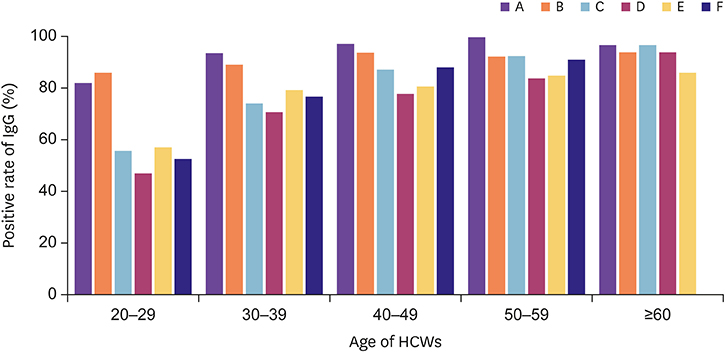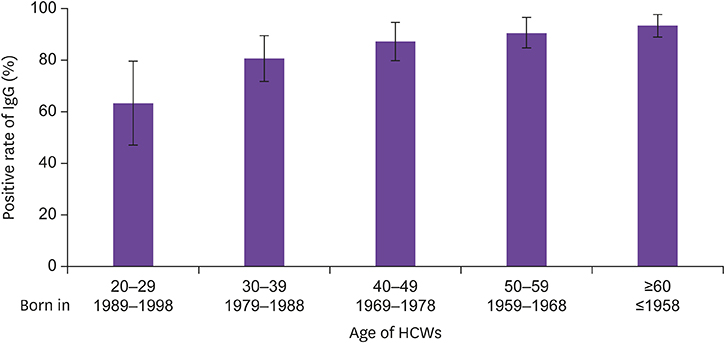Preliminary Report of Seroprevalence of Anti-Measles Immunoglobulin G among Healthcare Workers of 6 Teaching Hospitals of Daegu, Korea in 2019
- Affiliations
-
- 1Department of Internal Medicine, School of Medicine, Kyungpook National University, Kyungpook National University Hospital, Daegu, Korea. changhha@knu.ac.kr
- 2Department of Internal Medicine, School of Medicine, Kyungpook National University, Kyungpook National University Chilgok Hospital, Daegu, Korea.
- 3Department of Infectious Disease, Daegu Fatima Hospital, Daegu, Korea.
- 4Department of Infectious Disease, Keimyung University Dongsan Medical Center, Daegu, Korea.
- 5Department of Internal Medicine, Yeungnam University Medical Center, Daegu, Korea.
- 6Department of Internal Medicine, Catholic University of Daegu School of Medicine, Daegu, Korea.
- KMID: 2442222
- DOI: http://doi.org/10.3947/ic.2019.51.1.54
Abstract
- The measles outbreak in Daegu of January 2019 made 6 teaching hospitals' organization test the measles immunity of their healthcare workers (HCWs). We found that 6,935 (75.9%) of 9,132 HCWs tested seropositive for anti-measles immunoglobulin G (IgG), and seropositivity rate was very different between 6 hospitals (range, 59.9-93.1%). The seroprevelence was lowest in the age of twenties, but the rate was different between 6 hospitals (range 47.0-85.5%). Therefore, to prevent measles from spreading to HCWs, each hospital should make their own data periodically about anti-measles IgG seropositivity of their HCWs.
Keyword
MeSH Terms
Figure
Cited by 5 articles
-
Modified Measles in an Anti-Measles Immunoglobulin G-negative Healthcare Worker who had Received Two Doses of Measles-Containing Vaccine
Jung Wan Park, Shi Nae Yu, Eunkyeong Park, Yunseo Lee, Sun Mi Park, Min Hyok Jeon
Infect Chemother. 2019;51(3):305-309. doi: 10.3947/ic.2019.51.3.305.A Nationwide Survey on the Hospital Vaccination Policies in Korea
Sun Hee Park, Mi Suk Lee, Sung Ran Kim, Yee Gyung Kwak
J Korean Med Sci. 2020;35(12):. doi: 10.3346/jkms.2020.35.e76.Comparison of the Seroprevalence of Measles Antibodies among Healthcare Workers in Two Korean Hospitals in 2019
Yee Gyung Kwak, Je Eun Song, Gang-Bok Oh, In Hye Jeong, Chong Rae Cho, Namhee Kim, Hyeon Mi Yoo, Gyeong Min Yoo, Myung Jin Lee, Baek-Nam Kim
Infect Chemother. 2020;52(1):93-97. doi: 10.3947/ic.2020.52.1.93.Strategies for Minimizing Mealses Transmission in Korean Healthcare Facilities
Yong Chan Kim
Korean J Healthc Assoc Infect Control Prev. 2022;27(2):125-133. doi: 10.14192/kjicp.2022.27.2.125.A Usefulness of Serologic Screening of Measles and Hepatitis a for Healthcare Workers in a Tertiary Care Hospital
Hae Kyung Hong, Hyun A An, Myo Jeong kim, Eun Myung Kim, Tark Kim, Hee Bong Shin, Su Ha Han
Korean J Healthc Assoc Infect Control Prev. 2023;28(1):106-112. doi: 10.14192/kjicp.2023.28.1.106.
Reference
-
1. Choe YJ, Jee Y, Oh MD, Lee JK. Measles elimination activities in the Western Pacific region: experience from the Republic of Korea. J Korean Med Sci. 2015; 30:Suppl 2. S115–S121.
Article2. Choi WS, Sniadack DH, Jee Y, Go UY, So JS, Cho H, Bae GR, Lee DH, Kim K, Yoon HS, Chung YS, Kang C, Park H, Park O, Lee JK. Outbreak of measles in the Republic of Korea, 2007: importance of nosocomial transmission. J Infect Dis. 2011; 204:Suppl 1. S483–S490.
Article3. Yang TU, Kim JW, Eom HE, Oh HK, Kim ES, Kang HJ, Nam JG, Kim KS, Kim SS, Lee CK, Park YJ, Park O. Resurgence of measles in a country of elimination: interim assessment and current control measures in the Republic of Korea in early 2014. Int J Infect Dis. 2015; 33:12–14.
Article4. Kim SK, Park HY, Kim SH. A third dose of measles vaccine is needed in young Korean health care workers. Vaccine. 2018; 36:3888–3889.
Article5. Kang HJ, Han YW, Kim SJ, Kim YJ, Kim AR, Kim JA, Jung HD, Eom HE, Park O, Kim SS. An increasing, potentially measles-susceptible population over time after vaccination in Korea. Vaccine. 2017; 35:4126–4132.
Article6. Korean Society of Infectious Diseases (KSID). The Adult immunization schedule recommendation 2012 and 2017. Accessed January 25 2019. Available at: http://www.ksid.or.kr/data/sub07.html.7. Kumakura S, Shibata H, Onoda K, Nishimura N, Matsuda C, Hirose M. Seroprevalence survey on measles, mumps, rubella and varicella antibodies in healthcare workers in Japan: sex, age, occupational-related differences and vaccine efficacy. Epidemiol Infect. 2014; 142:12–19.
Article8. Bakri FG, Abdelrahim ZM, Alkalbani AS, Khrais GM, Shamroukh DS, Hayajneh FA, Mahafza A. Seroprevalence of measles, mumps, rubella, and varicella amongphysicians and nurses in Jordan. Turk J Med Sci. 2016; 46:614–619.
Article
- Full Text Links
- Actions
-
Cited
- CITED
-
- Close
- Share
- Similar articles
-
- Comparison of the Seroprevalence of Measles Antibodies among Healthcare Workers in Two Korean Hospitals in 2019
- Seroprevalence of Measles in Healthcare Workers in South Korea
- Modified Measles in an Anti-Measles Immunoglobulin G-negative Healthcare Worker who had Received Two Doses of Measles-Containing Vaccine
- Strategies for Minimizing Mealses Transmission in Korean Healthcare Facilities
- Two Cases of Vaccine-Associated Measles in Daegu, South Korea, 2019



